History of rice cultivation

Thehistory of rice cultivationis an interdisciplinary subject that studies archaeological and documentary evidence to explain howricewas first domesticated and cultivated by humans, the spread of cultivation to different regions of the planet, and the technological changes that have impacted cultivation over time.
The current scientific consensus, based on archaeological and linguistic evidence, is thatOryza sativarice was first domesticated in theYangtze Riverbasin in China 9,000 years ago.[1][2][3][4]Cultivation, migration and trade spread rice around the world—first to much of east Asia, and then further abroad, and eventually to the Americas as part of theColumbian exchange.The now less commonOryza glaberrimarice was independently domesticated in Africa around 3,000 years ago.[5]
Since its spread, rice has become a global staple crop important to food security and food cultures around the world. Local varieties ofOryza sativahave resulted in over40,000 cultivars of various types.More recent changes in agricultural practices and breeding methods as part of theGreen Revolutionand other transfers of agricultural technologies has led to increased production in recent decades.[6]
History
[edit]China
[edit]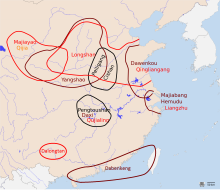
The scientific consensus based on archaeological and linguistic evidence, is that rice was first domesticated in theYangtze Riverbasin in China.[2][3][4]Because the functionalallelefornonshattering,the critical indicator of domestication in grains, as well as five othersingle-nucleotide polymorphisms,is identical in bothindicaandjaponica,Vaughanet al.(2008) determined a single domestication event forO. sativa.[2]This was supported by a genetic study in 2011 that showed that all forms of Asian rice, bothindicaandjaponica,sprang from a single domestication event that occurred some 9,000 years ago in China from the wild riceOryza rufipogon.[1][7]A more recent population genomic study indicates thatjaponicawas domesticated first, and thatindicarice arose whenjaponicaarrived in India about ~4,500 years ago and hybridized with an undomesticated proto-indicaor wildO. nivara.[8]
There are two most likely centers of domestication for rice as well as the development of thewetland agriculturetechnology. The first, and most likely, is in the lowerYangtze River,Liangzhu,andMaqiaocultures.Their diet were also supplemented byacorns,water chestnuts,foxnuts,andpigdomestication.[4][9][10][11]
The second is in the middle Yangtze River associated with thePengtoushan,Nanmuyuan,Liulinxi,Daxi,Qujialing,andShijiahecultures.Both of these regions were heavily populated and had regular trade contacts with each other, as well as with earlyAustroasiaticspeakers to the west, and earlyKra-Daispeakers to the south, facilitating the spread of rice cultivation throughout southern China.[9][10][12]

Rice was gradually introduced north into the earlySino-TibetanYangshaoandDawenkou culturemillet farmers, either via contact with theDaxi cultureor theMajiabang-Hemudu culture.By around 4000 to 3800 BC, they were a regular secondary crop among southernmost Sino-Tibetan cultures. It did not replace millet, largely because of different environment conditions in northern China, but it was cultivated alongside millet in the southern boundaries of the millet-farming regions. Conversely, millet was also introduced into rice-farming regions.[9][13] By the late Neolithic (3500 to 2500 BC), population in the rice cultivating centers had increased rapidly, centered around theQujialing-Shijiahe cultureand theLiangzhu culture.There was also evidence of intensive rice cultivation in paddy fields as well as increasingly sophisticatedmaterial culturesin these two regions. Both the number of settlements and overall settlement sizes increased among the Yangtze cultures, leading some archeologists to characterize them astrue states,with clearly advanced socio-political structures. However, it is unknown if they had centralized control.[14][15]
Liangzhu and Shijiahe declined abruptly in the terminal Neolithic (2500 to 2000 BC). With Shijiahe shrinking in size, and Liangzhu disappearing altogether. This is largely believed to be the result of the southward expansion of the early Sino-TibetanLongshan culture.Fortifications like walls (as well as extensive moats in Liangzhu cities) are common features in settlements during this period, indicating widespread conflict. This period also coincides with the southward movement of rice-farming cultures to theLingnanandFu gianregions, as well as the southward migrations of theAustronesian,Kra-Dai,andAustroasiatic-speaking peoples toMainland Southeast AsiaandIsland Southeast Asia.[14][16][17]A genomic study also indicates that at around this time, a global cooling event (the 4.2 k event) led to tropical japonica rice being pushed southwards, as well as the evolution of temperate japonica rice that could grow in more northern latitudes.[18]
Genomic studies suggests that indica rice was later introduced back to China from India between 2,000 and 1,400 years ago.[18]
Southeast Asia
[edit]The spread ofjaponicaricecultivation to Southeast Asia started with the migrations of theAustronesianDapenkeng cultureintoTaiwanbetween 3500 and 2000 BC (5,500BPto 4,000BP). The Nanguanli site in Taiwan, dated to ca. 2800 BC, has yielded numerous carbonized remains of both rice and millet in waterlogged conditions, indicating intensive wetland rice cultivation and dryland millet cultivation.[10]A multidisciplinary study using rice genome sequences indicate that tropical japonica rice was pushed southwards from China after a global cooling event (the4.2-kiloyear event) that occurred approximately 4,200 years ago.[18]

By 500 BC, there is evidence of intensive wetland rice agriculture already established in Java andBali,especially near very fertile volcanic islands.[10]


It has been speculated the rice did not survive the Austronesian voyages intoMicronesiadue to the sheer distance of ocean they were crossing and the lack of abundant rain. These voyagers became the ancestors of theLapita culture.By the time they migrated southwards to theBismarck Archipelago,they had already lost the technology of rice farming. However, there is no archaeological record of rice in Polynesia and Micronesia before or during the time of Lapita pottery fitting the hypothesis.[19]
Rice, along with other Southeast Asian food plants, were also later introduced toMadagascar,theComoros,and the coast ofEast Africaby around the 1st millennium AD by Austronesian settlers from theGreater Sunda Islands.[20]
Much later Austronesian voyages from Island Southeast Asia succeeded in bringing rice toGuamduring theLatte Period(AD 900 to AD 1700). Guam is the only island in Oceania where rice was grown in pre-colonial times.[21][22]
WithinMainland Southeast Asia,rice was presumably spread through river trade between the earlyHmong-Mien-speakers of the Middle Yangtze basin and the earlyKra-Dai-speakers of thePearl RiverandRed Riverbasins, as well as the earlyAustroasiatic-speakers of theMekong Riverbasin. Evidence for rice cultivation in these regions, dates to slightly later than the Dapenkeng settlement of Taiwan, at around 3000 BC. Southward migrations of the Austroasiatic and Kra-Dai-speakers introduced it into Mainland Southeast Asia. The earliest evidence of rice cultivation in Mainland Southeast Asia come from theBan Chiangsite in northernThailand(ca. 2000 to 1500 BC); and the An Sơn site in southernVietnam(ca. 2000 to 1200 BC).[10][23]A genomic study indicates that rice diversified into Maritime Southeast Asia between 2,500 and 1,500 years ago.[18]
Korean peninsula and Japanese archipelago
[edit]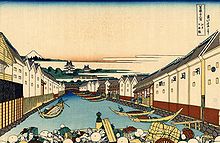
Mainstream archaeological evidence derived frompaleoethnobotanicalinvestigations indicate dry-land rice was introduced toKoreaandJapansometime between 3500 and 1200 BC. The cultivation of rice then occurred on a small scale, fields were impermanent plots, and evidence shows that in some cases domesticated and wild grains were planted together. The technological, subsistence, and social impact of rice and grain cultivation is not evident in archaeological data until after 1500 BC. For example, intensive wet-paddyrice agriculture was introduced into Korea shortly before or during the MiddleMumun pottery period(circa 850–550 BC) and reached Japan by the finalJōmonor initialYayoiperiodscirca300 BC.[24][25]A genomic study indicates that temperate japonica, which predominates in Korea and Japan, evolved after a global cooling event (the 4.2k event) that occurred 4,200 years ago.[18]
Indian subcontinent
[edit]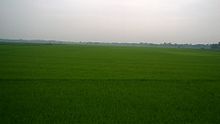
Evidence for rice consumption in India since 6000BCE is found at Lahuradewa in Uttar Pradesh.[26]However, whether or not the samples at Lahuradewa belong to domesticated rice is still disputed.[27]Rice was cultivated in the Indian subcontinent from as early as 5,000 BC.[28]"Several wild cereals, including rice, grew in theVindhyan Hills,and rice cultivation, at sites such as Chopani-Mando and Mahagara, may have been underway as early as 7,000BC. Rice appeared in theGangesvalley regions ofnorthern Indiaas early as 4530 BC and 5440 BC, respectively.[29]The early domestication process of rice inancient Indiawas based around the wild speciesOryza nivara.This led to the local development of a mix of 'wetland' and 'dryland' agriculture of localOryza sativavar.indicarice agriculture, before the truly 'wetland' riceOryza sativavar.japonica,arrived around 2000 BC.[30]
Rice was cultivated in theIndus Valley civilization(3rd millennium BC).[31]Agricultural activity during the second millennium BC included rice cultivation in theKashmirandHarrappanregions.[29]Mixed farming was the basis of Indus valley economy.[31]
O. sativawas recovered from a grave atSusain Iran (dated to the first century AD) at one end of the ancient world, while at the same time rice was grown in thePovalley in Italy. In northern Iran, inGilan province,manyindicarice cultivars including 'Gerdeh', 'Hashemi', 'Hasani', and 'Gharib' have been bred by farmers.[32]
Africa
[edit]
AlthoughOryza sativawas domesticated in Asia, the now less popularOryza glaberrimarice was independently domesticated in Africa 3,000 to 3,500 years ago.[5]Between 1500 and 800 BC,Oryza glaberrimapropagated from its original centre, theNiger Riverdelta,and extended to Senegal. However, it never developed far from its original region. Its cultivation even declined in favour of the Asian species, which was introduced to East Africa early in the common era and spread westward.[33]
Europe
[edit]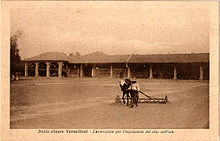

Rice was known to the Classical world, being imported from Egypt, and perhaps west Asia. It was known to Greece (where it is still cultivated inMacedoniaandThrace) by returning soldiers fromAlexander the Great's military expedition to Asia. Large deposits of rice from the first century AD have been found in Roman camps in Germany.[34]However it was not a staple of the Greek diet until the 10th century. Prior to this,barleyandwheatwere the primary grains cultivated and consumed in Greece. Over time, rice gradually replaced these traditional grains as a staple ingredient in many Greek dishes.
TheMoorsbrought Asiatic rice to theIberian Peninsulain the 8th century where it expanded progressively from the south. In Majorca, rice cultivation seems to have stopped after the Christianreconquest,although historians are not certain.[35]
The Moors may have also brought rice toSicily,with cultivation starting in the 9th century,[36]where it was an important crop[35]long before it is noted in the plain ofPisa(1468) or in the Lombard plain (1475), where its cultivation was promoted byLudovico Sforza,Duke of Milan, and demonstrated in his model farms.[37]
After the 15th century, rice spread throughout Italy and then France, later propagating to all the continents during the age of European exploration.
In Russia, a short-grain, starchy rice similar to the Italian varieties, has been grown in theKrasnodar Krai,and known in Russia as "Kuban Rice" or "Krasnodar Rice". In theRussian Far Eastseveraljaponicacultivars are grown inPrimoryearound theKhanka Lake.Increasing scale of rice production in the region has recently brought criticism towards growers' alleged bad practices in regard to the environment.
America
[edit]Recent research indicates that rice was independently domesticated in South America before the 14th century fromAmazon wild rice.[38]
Controversies
[edit]The origin ofOryza sativarice domestication has been a subject of much debate among those who study crop history and anthropology – whether rice originated in India or China.[39][40]Asian rice,Oryza sativa,is one of oldest crop species. It has tens of thousands of varieties and two major subspecies, japonica and indica. Archeologists focusing on East and Southeast Asia argue that rice farming began in south-central China along theYangtze Riverand spread to Korea and Japan from there south and northeast.[41][40]Archaeologists working in India argue that rice cultivation started in the valley of the Ganges River[42]and Indus valley,[43]by peoples unconnected to those of the Yangtze.[44][45][40]
A 2012 study, through genome sequencing and mapping of hundreds of rice varieties and that of wild rice populations, indicated that the domestication of rice occurred around the centralPearl Rivervalley region of southern China, in contradiction to archaeological evidence.[46]The study is based on modern distribution maps of wild rice populations which may be potentially inconclusive due to drastic climatic changes that happened during the end of thelast glacial period,ca. 12,000 years ago. However, the climate in regions north of the Pearl River would likely be less suitable for this wild rice. Human activity over thousands of years may also have removed populations of wild rice from their previous ranges. Based on Chinese texts, it is speculated there are populations of native wild rice along the Yangtze basin in c. AD 1,000 that have recently become extinct.[13]
An older theory, based on onechloroplastand twonuclear generegions, Londoet al.(2006) had proposed thatO. sativarice was domesticated at least twice—indicain easternIndia,Myanmar,andThailand;andjaponicain southernChinaandVietnam—though they concede that archaeological and genetic evidence exist for a single domestication of rice in the lowlands of southern China.[47]
In 2003, Korean archaeologists announced they discovered rice husks in Soro-ri, Korea, which dated to 13,000 BC, that they claimed show signs of having been cut by stone tools. These antedates the oldest grains found in China, which were dated to 10,000 BC, and potentially challenge the explanation that domesticated rice originated in the Yangtze River basin of China.[48][49]The findings were received by academia with strong skepticism and the claim remains dubious.[50][51][52]The dates claimed by the authors of the study at Soro-ri are disputed, since they did not use the much more reliableaccelerator mass spectrometry(AMS)carbon dating.A 2013 study using AMS carbon dating on seven samples of the actual rice husks have resulted in only one of the samples being dated to 12,520 ± 150 BP, with the other six being discovered to date to modern times. This inconsistency has not been explained. The evidence of the claimed cuts on the rice stalks are also inadequately explained. It is also unlikely for rice to be able to grow in Korea during theOldest Dryas,when the climate was much colder. Lastly, apart from the husks, no other remains of rice plants have been recovered from the site, which opens the possibility that even if the rice husks were as old as claimed, it is still more likely that they may have been transported from warmer regions in some manner (either by migratory birds or Paleolithic foragers) and were not grown there.[51][53][54]
Regional history
[edit]
Asia
[edit]Today, the majority of all rice produced comes from China, India, Indonesia,Bangladesh,Vietnam,Thailand,Myanmar,Philippines, Korea andJapan.Asian farmers still account for 87% of the world's total rice production. Because so much rice is produced in Bangladesh, it is also the staple food of the country.
Indonesia
[edit]Rice is a staple food for all classes in contemporaryIndonesia,[55][56]and it holds the central place inIndonesian cultureandIndonesian cuisine:it shapes the landscape; is sold at markets; and is served in most meals. Rice accounts for more than half of the calories in the average diet, and the source of livelihood for about 20 million households. The importance of rice in Indonesian culture is demonstrated through the reverence ofDewi Sri,the rice goddess of ancient Java and Bali.
Evidence of wild rice on the island ofSulawesidates from 3000 BC. Historic written evidence for the earliest cultivation, however, comes from eighth century stone inscriptions from the central island ofJava,which show kings levied taxes in rice. The images of rice cultivation, rice barn, and mice infesting a rice field is evident in Karmawibhangga bas-reliefs ofBorobudur.Divisions of labour between men, women, and animals that are still in place in Indonesian rice cultivation, were carved into relief friezes on the ninth centuryPrambanan templesinCentral Java:awater buffaloattached to a plough; women planting seedlings and pounding grain; and a man carrying sheaves of rice on each end of a pole across his shoulders (pikulan). In the sixteenth century, Europeans visiting the Indonesian islands saw rice as a new prestige food served to the aristocracy during ceremonies and feasts.[56]
Nepal
[edit]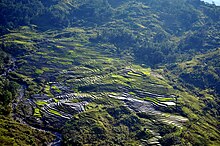
Rice is the major food amongst all the ethnic groups inNepal.In theTerai,most rice varieties are cultivated during therainy season.The principal rice growing season, known as "Berna-Bue Charne", is from June to July when water is sufficient for only a part of the fields; the subsidiary season, known as "Ropai" is from April to September, when there is usually enough water to sustain the cultivation of all rice fields. Farmers use irrigation channels throughout the cultivation seasons.[citation needed]Nepal's food security depends on the production of staple cereals with rice being the main cereal. Rice is grown on 1.49 million ha in Nepal with an average productivity of 3.5 t/ha and total annual production of 5.6 million tons in 2018 (MoALD, 2019).[57]
Philippines
[edit]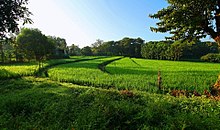
TheBanaueRice Terraces (Filipino:Hagdan-hagdang Palayan ng Banawe) are 2,000-year-oldterracesthat were carved into the mountains ofIfugaoin thePhilippinesby the ancestors of theIgorot people.The Rice Terraces are commonly referred to as the "Eighth Wonder of the World".[58][59][60]It is commonly thought that the terraces were built with minimal equipment, largely by hand. The terraces are located approximately 1,500 meters (5,000 ft) above sea level. They are fed by an ancientirrigationsystem from the rainforests above the terraces. It is said that if the steps were put end to end, it would encircle half the globe.[61]The terraces are found in the province of Ifugao and theIfugao peoplehave been its caretakers. Ifugao culture revolves[62][better source needed]around rice and the culture displays an elaborate array of celebrations linked with agricultural rites from rice cultivation to rice consumption. The harvest season generally calls for thanksgiving feasts, while the concluding harvest rites calledtangoortungul(aday of rest) entails a strict taboo on any agricultural work. Partaking of thebayah(rice beer), rice cakes, andbetel nutconstitutes an indelible practice during the festivities.
The Ifugao people practice traditional farming spending most of their labor at their terraces and forest lands while occasionally tending to root crop cultivation. The Ifugaos have also[61]been known to culture edible shells, fruit trees, and other vegetables which have been exhibited among Ifugaos for generations. The building of the rice terraces consists of blanketing walls with stones and earth which are designed to draw water from a main irrigation canal above the terrace clusters. Indigenous rice terracing technologies have been identified with the Ifugao's rice terraces such as their knowledge of water irrigation, stonework, earthwork and terrace maintenance. As their source of life and art, the rice terraces have sustained and shaped the lives of the community members.
Sri Lanka
[edit]
Rice is the staple food amongst all the ethnic groups inSri Lanka.Agriculture in Sri Lankamainly depends on the rice cultivation. Rice production is acutely dependent on rainfall and government supply necessity of water through irrigation channels throughout the cultivation seasons. The principal cultivation season, known as "Maha", is from October to March and the subsidiary cultivation season, known as "Yala", is from April to September. During Maha season, there is usually enough water to sustain the cultivation of all rice fields, nevertheless in Yala season there is only enough water for cultivation of half of the land extent. Traditional rice varieties are now making a comeback with the recent interest in green foods.
Thailand
[edit]
Rice is the main export of Thailand, especially white jasmine rice 105 (Dok Mali 105).[63]Thailand has a large number of rice varieties, 3,500 kinds with different characters, and five kinds of wild rice cultivates.[64]In each region of the country there are different rice seed types. Their use depends on weather, atmosphere, and topography.[65]
The northern region has both lowlands and high lands. The farmers' usual crop is non-glutinous rice[65]such as Niew Sun Pah Tong rice. This rice is naturally protected from leaf disease, and its paddy (unmilled rice) (Thai:ข้าวเปลือก) has a brown color.[66]The northeastern region is a large area where farmers can cultivate about 36 million square meters of rice. Although most of it is plains and dry areas,[67]white jasmine rice 105—the most famous Thai rice—can be grown there. White jasmine rice was developed inChonburi Provincefirst and after that grown in many areas in the country, but the rice from this region has a high quality, because it is softer, whiter, and more fragrant.[68]This rice can resist drought, acidic soil, and alkaline soil.[69]
The central region is mostly composed of plains. Most farmers grow Jao rice.[67]For example, Pathum Thani 1 rice which has qualities similar to white jasmine 105 rice. Its paddy has the color of thatch, and the cooked rice also has fragrant grains.[70]
In the southern region, most farmers transplant around boundaries to the flood plains or on the plains between mountains. Farming in the region is slower than other regions because the rainy season comes later.[67]The popular rice varieties in this area are the Leb Nok Pattani seeds, a type of Jao rice. Its paddy has the color of thatch, and it can be processed to make noodles.[71]
Companion plant
[edit]One of the earliest known examples ofcompanion plantingis the growing of rice withAzolla,the mosquito fern, which covers the top of a fresh rice paddy's water, blocking out any competing plants, as well as fi xing nitrogen from the atmosphere for the rice to use. The rice is planted when it is tall enough to poke out above the azolla. This method has been used for at least a thousand years.

Middle East and the Mediterranean Basin
[edit]Asiatic rice (Oryza sativa), although a latecomer to Mediterranean agriculture, was relatively widespread in antiquity and was not a product of the Islamic Agricultural Revolution. During theHellenistic period,rice was well known as far west asParthia,in modern northeasternIran.Diodorus(first century BCE) recognized rice as a significant Indian crop during the subcontinent's busy agricultural season.Strabo(first century CE) reported that rice was widely grown inBactria,Babylon,Susis,and also inLower Syria,based on second century BCE author Aristobulus. The crop traveled toAsia Minor(in modern-dayTurkey) during the early centuries CE.[72]
Texts from the late first and early second centuries imply that rice was first introduced toPalestinebyJewishfarmers during theEarly Roman period.Palestine's main crop was fine, large kernel rice. According to theJerusalem Talmud(3rd to 4th centuries CE), rice was grown inCaesarea,Paneas-Caesarea Phillipi,and the Chrysopolis area to the north of theSea of Galilee(in modern-dayIsrael).[72]
Galenrecommended the grain as a medicament in the second century, and his discipleOribasiusfollowed him in the fourth century.[72]
By the time the Muslims arrived in Iraq, rice was already widely farmed throughout the Sasanian kingdom. TheBabylonian Talmuddescribes its Mesopotamian cultivation, and implies it was an important part of the cuisine ofJews in Babylon.[72]Following the Islamic conquest, its cultivation moved north toNisibin,the southern shores of theCaspian Sea(inGilanandMazanderanprovinces of Iran)[32]and then beyond the Muslim world into the valley of theVolga.In Egypt, rice is mainly grown in theNile Delta.In Palestine, rice came to be grown in theJordan Valley.Rice is also grown in Saudi Arabia atAl-Ahsa Oasisand inYemen.[35]
Caribbean and Latin America
[edit]Most of the rice used today in the cuisine of the Americas is not native but was introduced to Latin America and the Caribbean byEuropeansat an early date. However, there are at least two native (endemic) species of rice present in the Amazon region of South America, and one or both were used by the indigenous inhabitants of the region to create the domesticated formOryza sp.,some 4000 years ago.[73]
Spanish colonizersintroducedAsian riceto Mexico in the 1520s atVeracruz,and thePortugueseand their African slaves introduced it at about the same time tocolonial Brazil.[74]Recent scholarship suggests thatenslaved Africansplayed an active role in the establishment of rice in theNew Worldand thatAfrican ricewas an important crop from an early period.[75]Varieties ofrice and beandishes that were a staple dish along the peoples of West Africa remained a staple among their descendants subjected toslavery in the Spanish New World colonies,Brazil and elsewhere in the Americas.[76]
Chile
[edit]TheRoyal GovernorAmbrosio O'Higginswas an early proponent of rice cultivation in Chile during his rule between 1788 and 1796.[77]The first rice cultivation occurred however much later, around 1920, yielding mixed results.[77]Various attempts in Central Chile followed, also yielding mixed results.[77]In part, the failure to establish successful rice cultivation in the first attempts is attributed to the indiscriminate use of rice varieties from areas with tropical climate that did not grow well in centralChile's temperate climate.[77]Early rice farmers had scant knowledge of the plant and learned chiefly by trial and error.[77]Years later temperate climate varieties were imported but these ended up being mixed with the previously imported tropical varieties producing seeds that were labelled "semilla nacional".[77]In the 1939–1940 season 13,190 hectares of rice existed in Chile and by this time rice cultivation had become one of the most profitable agricultural businesses in Chile.[77]In 1939 a division of the Ministry of Agriculture of Chile begun to study rice cultivated in Chile. This work continued in the research station Estación Genética de Ñuble in the 1940s.[77]Labour opportunities in the rice fields meant a salary increase and a generally improved economic situation for many rural workers.[77]However, as salaries increased between 1940 and 1964 the profitability also decreased.[77]Rice fields also used lands with poor clay-rich soils that were less suitable for other activities.[77]By 1964 38,000 ha of rice were cultivated.[77]Rice was cultivated as far south as the communeSan Carlos.[77]
North America
[edit]


In 1694, rice arrived inSouth Carolina,probably originating from Madagascar.[74]Tradition (possibly apocryphal) has it that pirateJohn Thurberwas returning from a slave-trading voyage to Madagascar when he was blown off course and put intoCharlestonfor repairs. While there he gave a bag of seed rice to explorer Dr.Henry Woodward,who planted the rice and experimented with it until finding that it grew exceptionally well in the wet Carolina soil.[79][80]
The mastery of rice farming was a challenge for the English and other European settlers who were unfamiliar with the crop. Native Americans, who mostly gatheredwild rice,were also inexperienced with rice cultivation. However, within the first fifty years of settlement rice became the dominant crop in South Carolina.[81]
In the United States,colonialSouth Carolina andGeorgiagrew and amassed great wealth from the slave labor obtained from theSenegambiaarea of West Africa and from coastal Sierra Leone. At the port of Charleston, through which 40% of all American slave imports passed, slaves from this region of Africa brought the highest prices due to their prior knowledge of rice culture, which was put to use on the many riceplantationsaroundGeorgetown,Charleston,andSavannah.
From the enslaved Africans, plantation owners learned how to dyke themarshesand periodically flood the fields. At first the rice was laboriously milled by hand using large mortars and pestles made of wood, then winnowed insweetgrassbaskets(the making of which was another skill brought by slaves from Africa). The invention of therice millincreased profitability of the crop, and the addition of waterpower for the mills in 1787 bymillwrightJonathan Lucas was another step forward.
Rice culture in the southeastern U.S. became less profitable with the loss of slave labor after theAmerican Civil War,and it finally died out just after the turn of the 20th century. Today, people can visit the only remaining rice plantation in South Carolina that still has the originalwinnowing barnand rice mill from the mid-19th century at the historicMansfield PlantationinGeorgetown, South Carolina.The predominant strain of rice in the Carolinas was from Africa and was known as 'Carolina Gold'. Thecultivarhas been preserved and there are current attempts to reintroduce it as a commercially grown crop.[82][dead link]
In the southern United States, rice has been grown in southernArkansas,Louisiana,and eastTexassince the mid-19th century. ManyCajunfarmers grew rice in wet marshes and low-lying prairies where they could also farmcrayfishwhen the fields were flooded.[83]In recent years rice production has risen in North America, especially in theMississippi embaymentin the states ofArkansasandMississippi(see alsoArkansas DeltaandMississippi Delta).
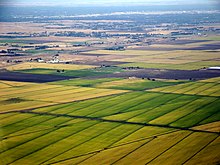
Rice cultivation began in California during theCalifornia Gold Rush,when an estimated 40,000 Chinese laborers immigrated to the state and grew small amounts of the grain for their own consumption. However, commercial production began only in 1912 in the town ofRichvaleinButte County.[84]By 2006, California produced the second-largest rice crop in the United States,[85]after Arkansas, with production concentrated in six counties north ofSacramento.[86]Unlike the Arkansas–Mississippi Delta region, California's production is dominated by short- and medium-grainjaponicavarieties, including cultivars developed for the local climate such asCalrose,which makes up as much as 85% of the state's crop.[87]
References to "wild rice"native to North America are to the unrelatedZizania palustris.[88]
More than 100 varieties of rice are commercially produced primarily in six states (Arkansas, Texas, Louisiana, Mississippi, Missouri, and California) in the U.S.[89]According to estimates for the 2006 crop year, rice production in the U.S. is valued at $1.88 billion, approximately half of which is expected to beexported.The U.S. provides about 12% of world rice trade.[89]The majority of domestic utilization of U.S. rice is direct food use (58%), while 16% is used in each of processed foods and beer. 10% is found in pet food.[89]
Oceania
[edit]Rice was one of the earliest crops planted in Australia by Britishsettlers,who had experience with rice plantations in the Americas and India.
Although attempts to grow rice in the well-watered north of Australia have been made for many years, they have consistently failed because of inherent iron andmanganesetoxicities in the soils and destruction bypests.
In the 1920s, it was seen as a possibleirrigationcrop on soils within theMurray–Darling basinthat were too heavy for the cultivation of fruit and too infertile for wheat.[90]
Because irrigation water, despite the extremely low runoff of temperate Australia,[91]was (and remains) very cheap, the growing of rice was taken up by agricultural groups over the following decades. Californian varieties of rice were found suitable for the climate in theRiverina,[90]and the first mill opened atLeetonin 1951.
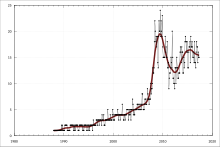
Even before this Australia's rice production greatly exceeded local needs,[90]and rice exports to Japan have become a major source of foreign currency. Above-average rainfall from the 1950s to the middle 1990s[92]encouraged the expansion of the Riverina rice industry, but its prodigious water use in a practically waterless region began to attract the attention of environmental scientists. These became severely concerned with declining flow in theSnowy Riverand the lowerMurray River.
Although rice growing in Australia is highly profitable due to the cheapness of land, several recent years of severe drought have led many to call for its elimination because of its effects on extremely fragile aquatic ecosystems. The Australian rice industry is somewhat opportunistic, with the area planted varying significantly from season to season depending on water allocations in theMurrayandMurrumbidgeeirrigation regions.
Australian Aboriginalpeople have harvested native rice varieties for thousands of years, and there are ongoing efforts to grow commercial quantities of these species.[93][94]
References
[edit]- ^abFornasiero, Alice; Wing, Rod A.; Ronald, Pamela (2022)."Rice domestication".Current Biology.32(1): R20–R24.Bibcode:2022CBio...32..R20F.doi:10.1016/j.cub.2021.11.025.ISSN0960-9822.PMID35015986.
- ^abcVaughan, DA; Lu, B; Tomooka, N (2008)."The evolving story of rice evolution".Plant Science.174(4): 394–408.Bibcode:2008PlnSc.174..394V.doi:10.1016/j.plantsci.2008.01.016.Archivedfrom the original on 2020-09-24.Retrieved2021-03-29.
- ^abHarris, David R. (1996).The Origins and Spread of Agriculture and Pastoralism in Eurasia.Psychology Press. p. 565.ISBN978-1-85728-538-3.
- ^abcZhang, Jianping; Lu, Houyuan; Gu, Wanfa; Wu, Naiqin; Zhou, Kunshu; Hu, Yayi; Xin, Yingjun; Wang, Can; Kashkush, Khalil (December 17, 2012)."Early Mixed Farming of Millet and Rice 7800 Years Ago in the Middle Yellow River Region, China".PLOS ONE.7(12): e52146.Bibcode:2012PLoSO...752146Z.doi:10.1371/journal.pone.0052146.PMC3524165.PMID23284907.
- ^abChoi, Jae Young (March 7, 2019)."The complex geography of domestication of the African rice Oryza glaberrima".PLOS Genetics.15(3): e1007414.doi:10.1371/journal.pgen.1007414.PMC6424484.PMID30845217.
- ^"Is basmati rice healthy?".K-agriculture. April 4, 2023.Archivedfrom the original on April 4, 2023.RetrievedApril 4,2023.
- ^Molina, J.; Sikora, M.; Garud, N.; Flowers, J. M.; Rubinstein, S.; et al. (2011)."Molecular evidence for a single evolutionary origin of domesticated rice".Proceedings of the National Academy of Sciences.108(20): 8351–8356.Bibcode:2011PNAS..108.8351M.doi:10.1073/pnas.1104686108.PMC3101000.PMID21536870.
- ^Choi, Jae; et al. (2017)."The Rice Paradox: Multiple Origins but Single Domestication in Asian Rice".Molecular Biology and Evolution.34(4): 969–979.doi:10.1093/molbev/msx049.PMC5400379.PMID28087768.
- ^abcdHe, Keyang; Lu, Houyuan; Zhang, Jianping; Wang, Can; Huan, Xiujia (June 7, 2017)."Prehistoric evolution of the dualistic structure mixed rice and millet farming in China".The Holocene.27(12): 1885–1898.Bibcode:2017Holoc..27.1885H.doi:10.1177/0959683617708455.S2CID133660098.Archivedfrom the original on November 20, 2021.RetrievedMarch 29,2021.
- ^abcdefBellwood, Peter (December 9, 2011)."The Checkered Prehistory of Rice Movement Southwards as a Domesticated Cereal—from the Yangzi to the Equator"(PDF).Rice.4(3–4): 93–103.Bibcode:2011Rice....4...93B.doi:10.1007/s12284-011-9068-9.S2CID44675525.Archived(PDF)from the original on January 24, 2019.RetrievedJanuary 24,2019.
- ^Hsieh, Jaw-shu; Hsing, Yue-ie Caroline; Hsu, Tze-fu; Li, Paul Jen-kuei; Li, Kuang-ti; Tsang, Cheng-hwa (December 24, 2011)."Studies on Ancient Rice—Where Botanists, Agronomists, Archeologists, Linguists, and Ethnologists Meet".Rice.4(3–4): 178–183.Bibcode:2011Rice....4..178H.doi:10.1007/s12284-011-9075-x.
- ^Li, Hui; Huang, Ying; Mustavich, Laura F.; Zhang, Fan; Tan, Jing-Ze; Wang, ling-E; Qian, Ji; Gao, Meng-He; Jin, Li (2007)."Y chromosomes of prehistoric people along the Yangtze River"(PDF).Human Genetics.122(3–4): 383–388.doi:10.1007/s00439-007-0407-2.PMID17657509.S2CID2533393.Archived fromthe original(PDF)on December 14, 2013.
- ^abFuller, Dorian Q. (2011)."Pathways to Asian Civilizations: Tracing the Origins and Spread of Rice and Rice Cultures".Rice.4(3–4): 78–92.Bibcode:2011Rice....4...78F.doi:10.1007/s12284-011-9078-7.
- ^abZhang, Chi; Hung, Hsiao-Chun (2008)."The Neolithic of Southern China – Origin, Development, and Dispersal"(PDF).Asian Perspectives.47(2).Archived(PDF)from the original on January 25, 2019.RetrievedJanuary 25,2019.
- ^Zhang, Chi (2013). "The Qujialing–Shijiahe culture in the middle Yangzi River valley". In Underhill, Anne P. (ed.).A Companion to Chinese Archaeology.John Wiley & Sons. pp. 510–534.ISBN9781118325780.
- ^Liu, Li; Chen, Xingcan (2012).The Archaeology of China: From the Late Paleolithic to the Early Bronze Age.Cambridge University Press.ISBN9780521643108.
- ^Major, John S.; Cook, Constance A. (2016).Ancient China: A History.Taylor & Francis.ISBN9781317503668.
- ^abcdeGutaker, Rafal; et al. (2020)."Genomic history and ecology of the geographic spread of rice"(PDF).Nature Plants.6(5): 492–502.Bibcode:2020NatPl...6..492G.doi:10.1038/s41477-020-0659-6.PMID32415291.S2CID218652494.Archived(PDF)from the original on 2021-02-26.Retrieved2021-03-29.
- ^"Deconstructing the Lapita Cultural Complex in the Bismarck Archipelago".
- ^Beaujard, Philippe (August 2011)."The first migrants to Madagascar and their introduction of plants: linguistic and ethnological evidence"(PDF).Azania: Archaeological Research in Africa.46(2): 169–189.doi:10.1080/0067270X.2011.580142.S2CID55763047.Archived(PDF)from the original on July 31, 2019.RetrievedJuly 31,2019.
- ^Carson, Mike T. (2012)."An overview of latte period archaeology"(PDF).Micronesica.42(1/2): 1–79.Archived(PDF)from the original on April 12, 2019.RetrievedJanuary 25,2019.
- ^Peterson, John A. (2012)."Latte villages in Guam and the Marianas: Monumentality or monumenterity?"(PDF).Micronesica.42(1/2): 183–08.Archived(PDF)from the original on April 12, 2019.RetrievedJanuary 25,2019.
- ^Higham, Charles F. W.; Douka, Katerina; Higham, Thomas F. G.; Hart, John P. (September 18, 2015)."A New Chronology for the Bronze Age of Northeastern Thailand and Its Implications for Southeast Asian Prehistory".PLOS ONE.10(9): e0137542.Bibcode:2015PLoSO..1037542H.doi:10.1371/journal.pone.0137542.PMC4575132.PMID26384011.
- ^Crawford; Shen (1998). "The Origins of rice agriculture: recent progress in East Asia".Antiquity.72(278): 858–866.doi:10.1017/S0003598X00087494.S2CID162486123.
- ^Crawford, G.W. & G.-A. Lee. (March 2003). "Agricultural Origins in the Korean Peninsula".Antiquity.77(295): 87–95.doi:10.1017/s0003598x00061378.S2CID163060564.
- ^Tewari, R, Srivastava, RK, Saraswat, KS, Singh, IB and Singh, KK. 2008.Early farming at Lahuradewa.Pragdhara, 18: 347–373.
- ^Ray, Avik; Chakraborty, Debarati; Ghosh, Surajit (2020)."A Critical Evaluation Revealed the Proto-indica Model Rests on a Weaker Foundation and Has a Minimal Bearing on Rice Domestication".Ancient Asia.11.doi:10.5334/aa.175.S2CID228845127.
- ^Murphy, Denis J. (2007).People, Plants and Genes: The Story of Crops and Humanity.Oxford University Press. p.178.ISBN978-0-19-920713-8.
- ^abSmith, C. Wayne (2000).Sorghum: Origin, History, Technology, and Production.John Wiley and Sons.ISBN0-471-24237-3.
- ^Bates, Jennifer (November 21, 2016)."Rice farming in India much older than thought, used as 'summer crop' by Indus civilisation".Research.Archivedfrom the original on March 30, 2019.RetrievedNovember 21,2016.
- ^abKahn, Charles (2005).World History: Societies of the Past.Portage & Main Press. 92.ISBN1-55379-045-6.
- ^abPazuki, Arman & Sohani, Mehdi (2013)."Phenotypic evaluation of scutellum-derived calluses in 'Indica' rice cultivars".Acta Agriculturae Slovenica.101(2): 239–47.doi:10.2478/acas-2013-0020.
- ^Maddox, Gregory [ed.] (2006).Sub-Saharan Africa: An Environmental History.ABC-CLIO. p. 267.ISBN1-85109-555-1.
- ^Sallare, Robert (1993),The Ecology of the Ancient Greek World,Cornell Univ. Press, p. 23,ISBN0-8014-2615-4.
- ^abcWatson,pp. 17–18
- ^S.D. Sharma (1957). "11 History of Rice in Europe".Rice: Origin, Antiquity and History.Taylor & Francis. p. 345.ISBN978-1-57808-680-1.
- ^Darby, H.C. (1957). "The face of Europe on the eve of the great discoveries".The New Cambridge Modern History.Vol. 1. p. 32.doi:10.1017/CHOL9780521045414.005.ISBN978-1-139-05576-5.
- ^Hilbert, L., Neves, E.G., Pugliese, F. et al. Evidence for mid-Holocene rice domestication in the Americas. Nat Ecol Evol 1, 1693–1698 (2017).https://doi.org/10.1038/s41559-017-0322-4
- ^"Rice originated in India".downtoearth.org.in.29 October 2011.Archivedfrom the original on August 5, 2020.RetrievedJune 7,2020.
- ^abc"Debating the Origins of Rice".Rice.July 5, 2018.Archivedfrom the original on August 8, 2020.RetrievedJune 7,2020.
- ^Huang, Xuehui; Kurata, Nori; Wei, Xinghua; Wang, Zi-Xuan; Wang, Ahong; Zhao, Qiang; Zhao, Yan; Liu, Kunyan; Lu, Hengyun; Li, Wenjun; Guo, Yunli (October 2012)."A map of rice genome variation reveals the origin of cultivated rice".Nature.490(7421): 497–501.Bibcode:2012Natur.490..497H.doi:10.1038/nature11532.ISSN1476-4687.PMC7518720.PMID23034647.
- ^Thakur, Biswajeet; Saxena, Anju; Singh, I (June 5, 2018)."Paddy cultivation during early Holocene: Evidence from diatoms in Lahuradewa lake sediments, Ganga Plain".Current Science.114(10): 2106.doi:10.18520/cs/v114/i10/2106-2115.
- ^Bates, J.; Petrie, C. A.; Singh, R. N. (February 1, 2017)."Approaching rice domestication in South Asia: New evidence from Indus settlements in northern India".Journal of Archaeological Science.78:193–201.Bibcode:2017JArSc..78..193B.doi:10.1016/j.jas.2016.04.018.ISSN0305-4403.PMC7773629.PMID33414573.
- ^Sandhya Ramesh (June 6, 2018)."India's rice history may not have had anything to do with China".ThePrint.Archivedfrom the original on June 7, 2020.RetrievedJune 7,2020.
- ^Varma, Subodh (November 21, 2016)."farming in india: Rice farming in India began much before Chinese rice arrived".The Times of India.Archivedfrom the original on July 10, 2020.RetrievedJune 7,2020.
- ^Huang, Xuehui; Kurata, Nori; Wei, Xinghua; Wang, Zi-Xuan; Wang, Ahong; Zhao, Qiang; Zhao, Yan; Liu, Kunyan; et al. (2012)."A map of rice genome variation reveals the origin of cultivated rice".Nature.490(7421): 497–501.Bibcode:2012Natur.490..497H.doi:10.1038/nature11532.PMC7518720.PMID23034647.
- ^Londo JP, Chiang YC, Hung KH, Chiang TY, Schaal BA (June 2006)."Phylogeography of Asian wild rice,Oryza rufipogon,reveals multiple independent domestications of cultivated rice,Oryza sativa".Proc. Natl. Acad. Sci. U.S.A.103(25): 9578–83.doi:10.1073/pnas.0603152103.PMC1480449.PMID16766658.
- ^Lee, Kyong-woo; Lee, Yung-jo; Woo, Jong-yoon; Lee, Seung-won (2017)."Advances of Multidisciplinary Research on Cheongju Sorori Rice".22 (2)d Suyanggae International Symposium in Sakhalin "the Initial Human Exploration of the Continental and Insular Parts of the Eurasia. Suyanggae and Ogonk:109–112.
- ^David, Dr (October 21, 2003)."Cf. BBC news (2003)".BBC News.Archivedfrom the original on November 12, 2013.RetrievedDecember 17,2012.
- ^Kim, Minkoo (2008). "Multivocality, Multifaceted Voices, and Korean Archaeology".Evaluating Multiple Narratives: Beyond Nationalist, Colonialist, Imperialist Archaeologies.New York: Springer.ISBN978-0-387-76459-7.
- ^abAhn, Sung-Mo (June 2010). "The emergence of rice agriculture in Korea: archaeobotanical perspectives".Archaeological and Anthropological Sciences.2(2): 89–98.Bibcode:2010ArAnS...2...89A.doi:10.1007/s12520-010-0029-9.S2CID129727300.
- ^Kim, Kyeong J.; et al. (2021). "Radiocarbon Ages of Suyanggae Paleolithic Sites in Danyang, Korea".Radiocarbon.63(5): 1429–1444.Bibcode:2021Radcb..63.1429K.doi:10.1017/RDC.2021.77.
- ^Shoda, Shinya; Nasu, Hiroo; Yamazaki, Kohei; Murakami, Natsuki; Na, Geon-Ju; Ahn, Sung-Mo; Yoneda, Minoru (8 May 2021)."Dry or Wet? Evaluating the Initial Rice Cultivation Environment on the Korean Peninsula".Agronomy.11(5): 929.doi:10.3390/agronomy11050929.
- ^Kim, Kyeong Ja; Lee, Yung-Jo; Woo, Jong-Yoon; Jull, A.J. Timothy (January 2013). "Radiocarbon ages of Sorori ancient rice of Korea".Nuclear Instruments and Methods in Physics Research Section B: Beam Interactions with Materials and Atoms.294:675–679.Bibcode:2013NIMPB.294..675K.doi:10.1016/j.nimb.2012.09.026.
- ^"Indonesian food."ArchivedSeptember 10, 2011, at theWayback MachineBelindoArchivedSeptember 7, 2011, at theWayback Machine.Accessed July 2011.
- ^abTaylor, Jean Gelman (2003).Indonesia: Peoples and Histories.New Haven and London: Yale University Press. pp.8–9.ISBN0-300-10518-5.
- ^Choudhary, Dyutiman; Banskota, Kamal; Khanal, Narayan Prasad; McDonald, Andrew James; Krupnik, Timothy J.; Erenstein, Olaf (2022)."Rice Subsector Development and Farmer Efficiency in Nepal: Implications for Further Transformation and Food Security".Frontiers in Sustainable Food Systems.5.doi:10.3389/fsufs.2021.740546.
- ^"'The Best of the Philippines – its natural wonders ".Filipinasoul.Archived fromthe originalon October 30, 2013.
- ^National Statistical Coordinating Body of the Philippines.FACTS & FIGURES:Ifugao provinceArchivedNovember 13, 2012, at theWayback Machine
- ^"About Banaue > Tourist Attractions".Archived fromthe originalon December 14, 2008.
- ^abDepartment of Tourism: Ifugao ProvinceArchivedMarch 2, 2009, at theWayback Machine.Accessed September 4, 2008.
- ^Vietnam & the Philippines. Wonders of the Asian World.World Heritage Sites and Schlessinger MediaISBN978-1-4171-0342-3.
- ^The genetic wonder of Thai rice, 1998
- ^Science and technology with Thai rice, National center for genetic engineering, 2003
- ^abThe ecology of life, p. 44, 1998
- ^Punkhao (Niew San Pah Tong), brrd.in.th, 2013
- ^abcThe ecology of life, p. 45, 1998
- ^The genetic wonder of Thai rice, p. 110,1998
- ^Punkhao (Khao Dawk Mali 105), brrd.in.th, 2013
- ^Punkhao (Pathum Thani 1), brrd.in.th, 2013
- ^Punkhao ( Leb Nok Pattani), brrd.in.th, 2013
- ^abcdDecker, Michael (2009).Tilling the Hateful Earth: Agricultural Production and Trade in the Late Antique East.Oxford: Oxford University Press. pp. 109–110.ISBN978-0-19-956528-3.OCLC316430311.
- ^Hilbert, Lautaro; Neves, Eduardo Góes; Pugliese, Francisco; Whitney, Bronwen S.; Shock, Myrtle; Veasey, Elizabeth; Zimpel, Carlos Augusto; Iriarte, José (2017)."Evidence for mid-Holocene rice domestication in the Americas"(PDF).Nature Ecology & Evolution.1(11): 1693–1698.Bibcode:2017NatEE...1.1693H.doi:10.1038/s41559-017-0322-4.PMID28993622.S2CID22917055.Archived(PDF)from the original on 2018-07-20.Retrieved2021-03-29.
- ^abWest, Jean M."Rice and Slavery".Archived from the original on January 1, 2007.RetrievedJune 24,2013.
{{cite web}}:CS1 maint: unfit URL (link).Retrieved on May 13, 2012. - ^Carney, Judith Ann (2001).Black rice: the African origins of rice cultivation in the Americas.Cambridge: Harvard University Press.ISBN978-0-674-00452-8.
- ^National Research Council (1996)."African Rice".Lost Crops of Africa: Volume I: Grains.Vol. 1. National Academies Press.doi:10.17226/2305.ISBN978-0-309-04990-0.Archivedfrom the original on January 22, 2009.RetrievedJuly 18,2008.
- ^abcdefghijklmParedes C., Mario; Becerra V., Viviana; Donosos Ñ., Gabriel (2021). "Historia de la producción de arroz en Chile. 1920-2020". In Paredes C., Mario; Becerra V., Viviana; Donosos Ñ., Gabriel (eds.).100 años del cultivo del arroz en Chile en un contexto internacional 1920-2020.Colección Libros INIA - Instituto de Investigaciones Agropecuarias (in Spanish). Vol. 40. pp. 314–379.
- ^Carney, Judith A. (2002-12-31).Black Rice.doi:10.4159/9780674262539.ISBN9780674262539.
- ^"The History of U.S. Rice Production – Part 1".Louisiana State University Agricultural Center.13 January 2017.Archivedfrom the original on September 4, 2017.RetrievedSeptember 3,2017.
- ^Campbell, Gwyn (2012).David Griffiths and the Missionary "History of Madagascar".Leiden NL: BRILL. pp. 448–49.ISBN978-90-04-19518-9.Archivedfrom the original on February 7, 2017.RetrievedSeptember 3,2017.
- ^Heuman, Gad J. (2003).The Slavery Reader.Routledge.ISBN9780415213035.
- ^Carolina Gold Rice FoundationArchivedJune 20, 2006, at theWayback Machine.Carolina Gold Rice Foundation. Retrieved on May 13, 2012.
- ^Farm Raised CrawfishArchivedOctober 28, 2014, at theWayback Machine.Crawfish. Retrieved on May 13, 2012.
- ^Lee, Ching (2005)."Historic Richvale – the birthplace of California rice".California Farm Bureau Federation. Archived fromthe originalon October 11, 2007.RetrievedAugust 10,2007.
- ^"California's Rice Growing Region".California Rice Commission. Archived fromthe originalon February 10, 2006.RetrievedAugust 10,2007.
- ^Sumner, Daniel A.; Brunke, Henrich (September 2003)."The economic contributions of the California rice industry".California Rice Commission. Archived fromthe originalon April 26, 2006.RetrievedAugust 10,2007.
- ^"Medium Grain Varieties".California Rice Commission. Archived fromthe originalon May 8, 2006.RetrievedAugust 10,2007.
- ^"Information about Wild Rice".mnwildrice.Archived fromthe originalon June 16, 2016.RetrievedDecember 31,2016.
- ^abcStates Department of AgricultureArchivedMarch 4, 2016, at theWayback MachineAugust 2006, Release No. 0306.06, U.S. Rice Statistics
- ^abcWadham, Sir Samuel; Wilson, R. Kent and Wood, Joyce;Land Utilization in Australia,Melbourne University Press (1957) p. 246
- ^See McMahon T.A. and Finlayson, B.;Global Runoff: Continental Comparisons of Annual Flows and Peak DischargesISBN3-923381-27-1
- ^Australian Bureau of Meteorology;Climatic Atlas of Australia: Rainfall,Bureau of Meteorology, Melbourne, Victoria (2000)
- ^"Wild for Aussie rice".Australian Broadcasting Corporation.May 15, 2014.Archivedfrom the original on December 23, 2017.RetrievedDecember 26,2017.
- ^"Alpine Rice | Australia's first commercial native grain crop. © 2013".Archivedfrom the original on December 27, 2017.RetrievedDecember 26,2017.

